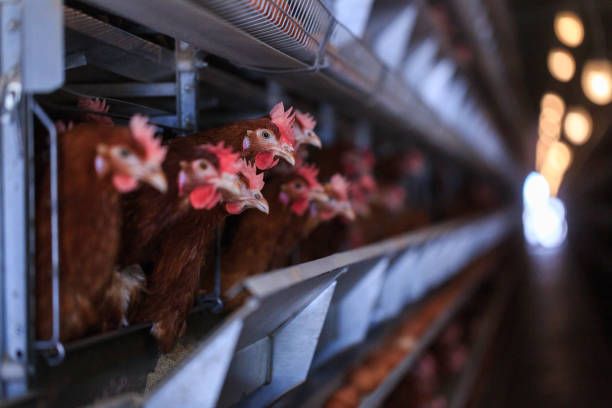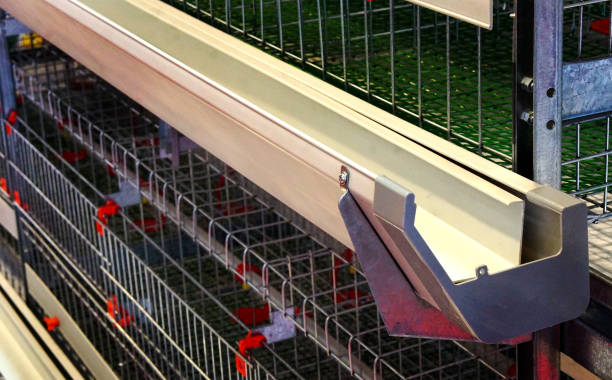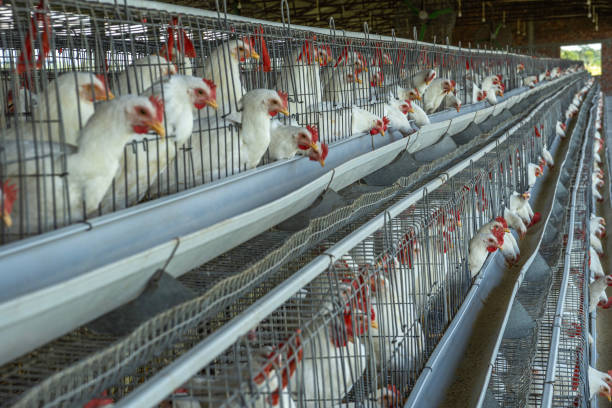
Investing in a 20,000 Bird Poultry Cage System: A Smart Move for Your African Poultry Business
Investing in a 20,000 Bird Poultry Cage System: A Smart Move for Your African Poultry Business
The African poultry industry is booming. As demand for chicken meat and eggs continues to rise across the continent, more and more entrepreneurs are seeking to capitalize on this lucrative market. However, simply raising chickens is no longer enough to guarantee success. To truly thrive in today’s competitive landscape, poultry farmers need to embrace modern farming techniques and invest in efficient, scalable solutions. One of the most impactful investments you can make is in a well-designed poultry cage system, particularly a 20,000 bird capacity system. Why 20,000 birds? Because it strikes a sweet spot, offering significant economies of scale while remaining manageable for many farms.
But before you rush into any purchase, let’s delve into the nitty-gritty of why a 20,000 bird poultry cage system could be the game-changer your African poultry business needs.
Understanding the Benefits: Why Cages?
First, let’s address any misconceptions about poultry cages. Modern cage systems aren’t the cramped, inhumane environments of the past. Instead, they are designed with the well-being of the birds in mind, focusing on optimizing space, hygiene, and overall productivity. The key benefits are:
Increased Space Utilization: Cage systems dramatically increase the number of birds you can house in a given area. Compared to free-range or deep litter systems, cages allow for higher stocking densities without compromising bird welfare– when managed correctly. With proper ventilation, lighting, and feeding, birds in cages can thrive.
Improved Hygiene and Disease Control: By separating birds from their droppings, cages significantly improve hygiene. Waste falls through the cage floor, minimizing contact and reducing the risk of disease outbreaks, such as coccidiosis or E. coli. This translates to lower mortality rates and reduced reliance on antibiotics, crucial for both profitability and responsible farming. Regular cleaning of the manure collection system is important.
Enhanced Egg Production: In egg-laying operations, cage systems streamline egg collection. Eggs roll gently onto a collection belt, minimizing breakage and contamination. This also allows for accurate tracking of egg production per cage, helping you identify and address any issues promptly. With efficient feeding and watering systems, hens have consistent access to what they need to reach their full laying potential. Providing quality feed is key.

Reduced Labor Costs: Automated feeding, watering, and egg collection systems significantly reduce labor requirements. This frees up your workforce to focus on other critical tasks, such as monitoring bird health, managing inventory, and marketing your products. The savings in labor can be substantial, particularly in regions where labor costs are rising.
Better Bird Management: Cages allow for easier monitoring of individual birds. You can quickly identify sick or injured birds and provide timely treatment. This individualized attention is more difficult to achieve in larger, open housing systems. This close monitoring also helps in identifying high or low producing hens.
Why 20,000 Birds? Finding the Right Scale
Choosing the right capacity for your poultry operation is vital. While a smaller system might seem more manageable at first, it can limit your potential for growth. On the other hand, a system that’s too large can overwhelm your resources. A 20,000 bird poultry cage system often represents an ideal balance for many African poultry businesses, offering several advantages:
Economies of Scale: A 20,000 bird system allows you to take advantage of bulk discounts on feed, medication, and other supplies. This can significantly reduce your operating costs and improve your profit margins. The larger volume of eggs or meat you produce also gives you more bargaining power with buyers.
Streamlined Operations: With automated systems in place, managing 20,000 birds becomes surprisingly efficient. Centralized feeding and watering systems ensure that all birds receive adequate nutrition and hydration. Automated egg collection or broiler removal streamlines the harvesting process.
Meeting Market Demand: A 20,000 bird operation produces a significant volume of eggs or meat, enabling you to meet the demands of larger retailers, restaurants, and wholesalers. This opens up new market opportunities and allows you to establish long-term relationships with key customers.
Financial Viability: A well-managed 20,000 bird poultry farm can generate substantial revenue. The increased production efficiency and reduced operating costs translate to higher profits, making your business more sustainable and attractive to investors. It also makes you more competitive against less efficient producers.
Key Considerations Before Investing
Before investing in a 20,000 bird poultry cage system, it’s crucial to carefully consider the following factors:
Land Availability: Ensure you have enough land to accommodate the poultry house, feed storage facilities, and waste management systems. Consider future expansion plans when selecting your site. Proper drainage is essential.
Climate Control: African climates can be harsh, with extreme temperatures and humidity. Invest in a well-ventilated poultry house with adequate insulation to regulate temperature and humidity levels. Consider supplemental cooling or heating systems if necessary.
Water Supply: Chickens require a constant supply of fresh, clean water. Ensure you have access to a reliable water source and invest in a water treatment system if needed. Water storage tanks are also advisable.
Feed Management: Develop a comprehensive feed management plan to ensure your birds receive the right nutrients at each stage of their life. Consider sourcing feed locally to reduce transportation costs. Maintaining proper storage to prevent spoilage is crucial.
Waste Management: Implement a sustainable waste management system to dispose of chicken manure responsibly. This could involve composting, biogas production, or using the manure as fertilizer for crops. Compliance with environmental regulations is important.

Biosecurity: Implement strict biosecurity measures to prevent the introduction and spread of diseases. This includes controlling access to the farm, disinfecting vehicles and equipment, and implementing a vaccination program. Employee training is critical for biosecurity.
Power Supply: Ensure a reliable power supply to operate automated systems. Consider investing in a backup generator in case of power outages. Solar power can be a cost-effective and environmentally friendly alternative.
Financing: Develop a detailed business plan to secure financing from banks or other lenders. Consider government grants or subsidies that may be available to support poultry farming.
Choosing the Right Cage System Supplier
Selecting the right poultry cage system supplier is critical to the success of your project. Look for a supplier with:
Experience in the African Market: A supplier familiar with the specific challenges and opportunities of the African poultry industry can provide valuable insights and support.
High-Quality Products: Choose a supplier that uses durable, corrosion-resistant materials to ensure the longevity of the cage system.
Customization Options: A good supplier should be able to customize the cage system to meet your specific needs and preferences.
Installation and Training Services: Ensure the supplier provides professional installation services and comprehensive training for your staff.
After-Sales Support: Choose a supplier with a reliable after-sales support network to provide maintenance, repairs, and spare parts.
Positive Reputation: Research the supplier’s reputation by reading online reviews and talking to other poultry farmers.
Specific Cage System Types to Consider
Different types of cage systems cater to different needs and budgets. Here’s a brief overview:
A-Frame Cages: These are the most common type, offering a simple and cost-effective solution for egg-laying hens or broilers.

H-Frame Cages: These cages offer higher stocking densities and improved ventilation.
Layer Cages: Specifically designed for egg production, with features such as egg collection belts and automatic feeding systems.
Broiler Cages: Designed for raising meat chickens, with durable construction and easy access for harvesting.
Battery Cages: While traditionally offering high densities, increasingly scrutinized for animal welfare concerns, be aware of local regulations.
When choosing a cage system, consider the specific needs of your birds, your budget, and your long-term goals. Researching different reputable manufacturers ensures you get suitable, durable equipment like from Livi Machinery, which is dedicated in poultry cage manufacturing for decades with good reputation especially in African and Southeast Asian countries.
Ongoing Management: The Key to Success
Investing in a 20,000 bird poultry cage system is just the first step. To achieve long-term success, you need to implement sound management practices:
Maintain strict biosecurity protocols.
Provide adequate nutrition and hydration.
Monitor bird health closely.
Implement a regular cleaning and disinfection schedule.
Keep accurate records of production, costs, and mortality.
Stay up-to-date on the latest industry trends and best practices.
Invest in ongoing training for your staff.
Adapt your strategies based on market changes and feedback.
By following these guidelines, you can maximize the potential of your 20,000 bird poultry cage system and build a thriving poultry business in Africa. The combination of smart technology, efficient management, and a clear understanding of the market will set you apart from the competition and secure your place in the growing African poultry industry. Remember: poultry farming is a business, and like any business, it requires careful planning, investment, and dedication to succeed. However, the potential rewards are well worth the effort. So, do your research, plan meticulously, and take the leap! The future of poultry farming in Africa is bright, and with a 20,000 bird poultry cage system, you can be a part of it.
